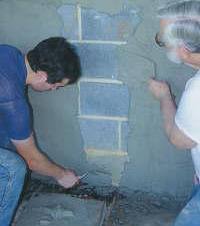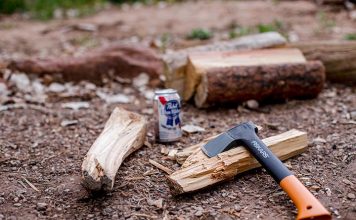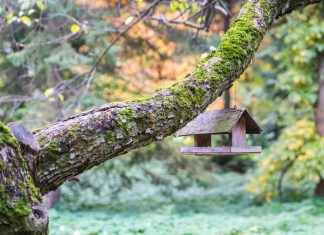| Issue #57 • May/June, 1999 |
You can say a great deal in favor of cement block (or, if you prefer, concrete block) building. It’s fairly fast, reasonably easy, particularly in small projects, and incredibly cheap if you are willing to scrounge a little and salvage the block.
But one thing you can’t say about the traditional concrete blocks is that they are pretty. In fact, cement blocks, unless you buy some of the decorative ones or paint the regular ones, can be, and often are, as ugly as a mud fence.
But, some of you are asking, what on earth is parging. Or you may prefer the “pargeting” spelling. It doesn’t matter whether you pronounce it par-jay or parj. But for those of you who do not know, parging is simply the act of mixing a batch of mortar, then applying it to a wall of some sort. In this article that wall is the foundation of a house, but you can do it for anything else you want covered.
 Use a gloved hand to push the sand around the screen until the fine particles fall through the mesh and the larger particles are left on the screen. Discard the large particles. Use a gloved hand to push the sand around the screen until the fine particles fall through the mesh and the larger particles are left on the screen. Discard the large particles. |
You may also think of parging as applying a form of stucco to a wall. In fact, stucco, by definition in the modern sense, is mixing portland cement, lime, and water and applying it onto a wall for decorative purposes. In another context stucco is a fine plaster used to cover a wall.
What we are talking about here is covering ugly cement blocks so they will have a more aesthetically pleasing look.
Here’s a simple way to mix the plaster or stucco. Start with an 80-pound bag of portland cement, 70 pounds of masonry sand, an appropriate amount of water, and ambition. Now here’s how you can cut your expenses slightly. Instead of buying the masonry sand, you can use sand dug from a creek bed or from alongside a country road.
Now you are ready to sift the sand, which should be dry when you start. We use an old screen that is fit for nothing else. We place the screen over a mortar pan (you can also use a wheelbarrow, plywood box, or whatever else will hold the mixture). Pour a small amount (10 pounds or so) onto the screen, then shake the screen gently back and forth until all the fine sand is sifted into the mortar box. You can also use your hand (if you wear gloves you save wear and tear on your flesh) and rub the sand back and forth until only the coarser materials are left. When you have a 70-pound batch of sifted sand, you are ready to dump in half a bag of the portland cement.
Rest assured that there is no magic in getting the weights or volumes down to the grain or the macro-ounce. If you are close, it will work pretty well. Mix by using a garden hoe and shovel, if you need one, until the sand and cement are well mixed.
 Use a trowel to smear the parget material over the surface of the dampened cement blocks. Lap over the final part of the wet mortar each time you apply another trowel-ful of mortar. Use a trowel to smear the parget material over the surface of the dampened cement blocks. Lap over the final part of the wet mortar each time you apply another trowel-ful of mortar. |
Now add water. Start with a small amount and rake the mixture back and forth until the water is absorbed. Add more and more water and keep mixing until the mixture will absorb no more liquid. The final consistency should be such that if you turn the hoe blade to a diagonal position and pull it through the mixture, the cement should barely hold its form. In fact, you may want to add water (for the final work, at least) until the consistency is even more liquid.
To apply the mixture, you will need a hose with a nozzle on it (or you can use a small container for the purposethis to be explained shortly) and a trowel or two. If you will be covering huge spaces, you will cover more wall faster with a huge trowel. If you plan to do small and close work, where neatness is the most important consideration, use a small trowel.
When the mixture is ready, lay down some drop cloths (or, as we did, some old cardboard boxes laid edge to edge and pushed up against the wall). If you are working in an area where neatness is not a consideration, such as the wall of the underground part of a foundation wall where back-filling will occur later, you need not be too concerned about some dropped mortar.
When you are ready, spray a mist of water (or use a small bucket and splash water on the area to be parged) so that you have a small amount of dampness on the wall. Why? The explanation that is usually offered is that mortar forms a bond as moisture inside the blocks is pulled out as the moisture from the mortar is also pulled inward. If there is no moisture in the blocks, all the moisture from the mortar will be sucked into the blocks, leaving the mortar dry and crumbly before it can set fully.
Start at one corner or other boundary or limit of the wall. Be sure to wet the trowel before you start, just as you wet the mortar pan, the hoe, and the shovel before you begin the mixing. Hold the trowel upside down, scoop it into the mortar, and “load up” the backside of the trowel. Hold the trowel low, if you are starting at the bottom, and smear the mortar upward and finish the arc in front of your body and at a point two to three feet higher than the point where you started.
The next arc should overlap the previous, so there are no places left uncovered. As you apply the mortar, press inward with gentle pressure to force the mortar into the pores of the blocks.
If you did not sift your sand well (and some of the sand you buy at hardware stores has not been sifted properly) you will feel small pieces of gravel rolling under the trowel, and you can see the path of the gravel because it leaves a small path through the mortaran unsightly trail, at that.
 Use a wet trowel to smooth the still damp surface. The thinner the mortar, the easier it is to get a smooth surface. You will be amazed at the difference that parging makes on the surface of the blocks and on the general appearance of the house. Use a wet trowel to smooth the still damp surface. The thinner the mortar, the easier it is to get a smooth surface. You will be amazed at the difference that parging makes on the surface of the blocks and on the general appearance of the house. |
If you are applying a scratch coat, you need not worry about keeping the surface smooth. If, however, the first coat is also the last coat, you will want a smooth surface. To achieve this smooth appearance, apply a thicker coat of mortar, then apply a thinner coat on top of the first application. You can even omit the second coat and simply dip your trowel into a bucket of water then smooth the parged surface with the dripping trowel.
Around windows, doors, and other interruptions in the wall line you need to use either a small trowel or great care and a steady hand. Mortar smears on unwanted surfaces should be cleaned before the mortar dries.
When you remove the drop cloth (or cardboard boxes) you will need to fill in the tiny spaces where the floor protector met the wall. For best results, work in small sections, wetting the smaller area then covering it before moving to another area and repeating the process.
Don’t let the outside or fringe area of the first section dry before you lap it with fresh mortar. When you must stop for the night or for long periods of time, try to complete work to a corner or other wall interruption.
It is good to work under cloudy weather on hot days. If the temperature is extremely high, stop and spray or mist the covering of the wall periodically to prevent too-fast drying.
When you have finished work, or when you plan to stop for more than a half hour or so, rinse the shovel, trowel, and hoe to clean away all mortar. Clean the mortar box at the end of the day.
Be sure to take a picture of the area before and after the parget work. You’ll be amazed at the appearance of the work area.















Will this also help to keep water from seeping into the basement???
Can this be done to painted blocks
Thanx for the very useful information. I would like to parse an old block wall to my church. The blocks are almost black with what I would guess is black mold. Would this have to be removed before the stucco is applied?
My customer has a poolside wall that contains a waterfall feature. The pool and waterfall feature use salt water. The wall is constructed using cinder blocks and had a stone veneer mortared to it, but it has all detached. Would parging be suitable for resurfacing the wall? Would the salt water cause it to fail over time? The salt water doesn’t flow over the wall, or come in contact with it, except when splashed on it from the pool. Do you have any other ideas as what to use to resurface the wall to make it look nice?
Thanks!
Can this be done in a basement with cinder block walls? Just trying to hide that ugly look.